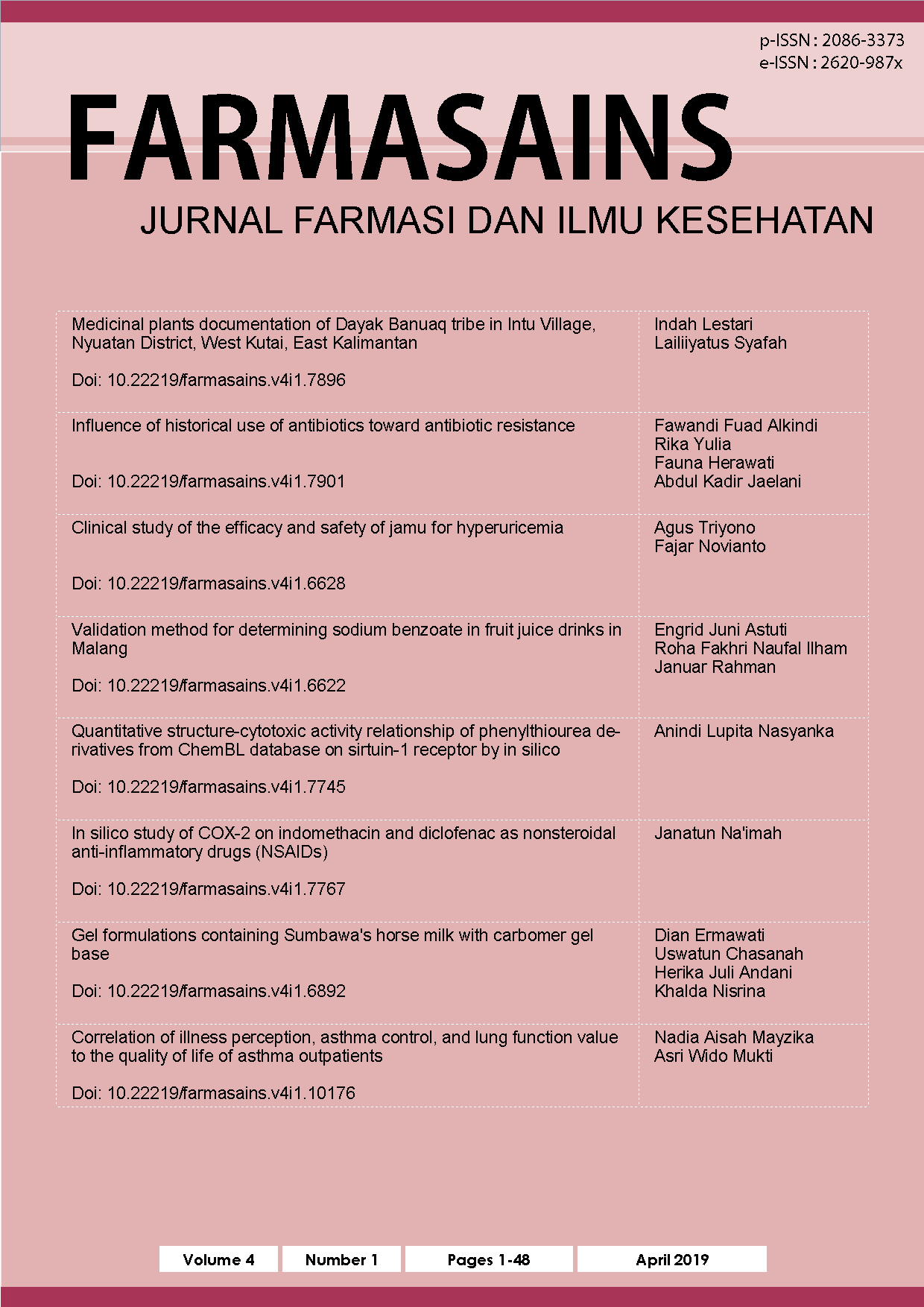Validation method for determining sodium benzoate in fruit juice drinks in Malang
DOI:
https://doi.org/10.22219/farmasains.v4i1.6622Keywords:
Validation, Sodium benzoate, HPLC, Fruit juice drink, MalangAbstract
Sodium benzoate is a preservative that is permitted to be used in food and beverages. The maximum limit for using sodium benzoate in food is 600 mg/L of ingredients calculated as benzoic acid. In this study, High-Performance Liquid Chromatography (HPLC) method using a PDA detector was used for sodium benzoate levels analysis in fruit juice drink circulating in Malang. The mobile phase composition used in this study was methanol pro-HPLC:aqua pro injection (70:30) and added glacial acetic acid to reach pH 3. The analysis was conducted at a wavelength of 245 nm, and the flow rate was set at 1.00 mL/minute. This method was validated against the parameters of selectivity, linearity, accuracy, and precision, and the results obtained to meet the validation requirements. The application of the HPLC method after being validated in the determination of sodium benzoate levels in fruit juice drink circulating in Malang resulted in selectivity Rs ≥ 1.5, linearity obtained in the range 0.1-5 μg/mL with a correlation coefficient (r) = 0,9999, recovery at a concentration of 80%, 100%, and 120% was 105.31%, and precision with an RSD value of 1.40%. Based on the results, it can be concluded that the validation method of analysis shows that the method can be used to determine sodium benzoate level using HPLC with PDA detectors for routine use in fruit juice drink samples.Downloads
References
Altiokka, G., Ergun, B., Nafiz, O. C., & Aboul-Enein, B. H. (2015). Validated Reversed Phase HPLC Method for The Analysis of The Food Additive, Sodium Benzoate in Soft Drinks and Jams. Journal of Liquid Chromatography and Related Technologies, 30(8), 1125-1136. doi:10.1080/10826070601128501.
Badan Pengawas Obat dan Makanan. (2013). Peraturan Kepala Badan Pengawas Obat dan Makanan Republik Indonesia Nomor 23 Tahun 2013 Tentang Batas Tambahan Makanan dan Penguat Rasa. Jakarta, Indonesia: Author.
Badan Standardisasi Nasional. (1995). Minuman Sari Buah: SNI 01-3719-1995. Jakarta, Indonesia: Author.
Gandjar, I. G., & Rohman, A. (2012). Kimia Farmasi Analisis. Yogyakarta, Indonesia: Pustaka Pelajar.
Harmita, R. M. (2005). Buku Ajar Analisis Hayati. Jakarta, Indonesia: Percetakan Ari Cipta.
Internatinal Conference of Harmonisation. (1996). Validation of Analytical Procedures: Text and Methodology Q2(R1). Geneva, Swiss: Author.
Isran., Karimuna, L., & Sadimantara, M. S. (2016). Analisis Kandungan Zat Pengawet Narium Benzoat Pada Saus Tomat di Pasar Tradisional Andounohu Kota Kendari. Jurnal Sains dan Teknologi Pangan, 1(2), 131-135.
Maga, J. A., & Tu, A. T. (1994). Food Addictive Toxicology. New York, NY: Marcel Dekker.
Rahmawati, Kosman, R., Effendi, N., & Ismayani, N., (2014). Analisis Kadar Pengawet Natrium Benzoat Pada Produk Minuman Berkarbonasi Dengan Metode HPLC. As-Syifaa Jurnal Farmasi, 6(2), 112-117.
Rustian, R., Rusdi, B., & Rusnadi., (2015). Analisis Kuantitatif Pengawet Natrium Benzoate Pada Susu Kedelai yang Dijual di Daerah Cibuntu Menggunakan Spektrofotometri UV Sinar Tampak. Prosiding Farmasi, 1(1), 136-141.
Sumantri, A. R. (2007). Analisis Makanan. Yogyakarta, Indonesia: Gadja Mada University Press.
Suryaningrum, A. (2017). Analisis Kadar Bahan Pengawet Natrium Benzoat Pada Minuman Isotonik Merek X Secara Spektrofotometri UV-VIS. Pharmaceutical and Traditional Medicine, 1(1), 38-42.
Wati, W.I., & Guntarti, A., (2012). Penetapan Kadar Asam Benzoat Dalam Beberapa Merk Dagang Minuman Ringan Secara Spektrofotometri Ultraviolet. Pharmaciana, 2(2), 111-118. doi:10.12928/pharmaciana.v2i2.661.
Yulinda, (2015). Analisis Kadar Pengawet Natrium Benzoat Pada Saos Tomat Di Pasar Sekip Kota Palembang dan Sumbangsihnya Pada Materi Zat Aditif Pada Makanan di Kelas VIII SMP/MTS. (Undergraduate thesis. Universitas Islam Negeri Raden Fatah, Palembang, Indonesia. Retrieved from http://eprints.radenfatah.ac.id/559/1/YULINDA_TarBio.pdf.
Yuwono, M., & Indrayanto, G., (2005). Validation of chromatographic methods of analysis. Profiles of drug substances, excipients, and related methodology, 32, 243-259. doi:10.1016/S0099-5428(05)32009-0.
Downloads
Published
How to Cite
Issue
Section
License
Copyright (c) 2019 Engrid Juni Astuti, Roha Fakhri Naufal Ilham, Januar Rahman

This work is licensed under a Creative Commons Attribution 4.0 International License.
Authors who publish with this journal agree to the following terms:
a. Authors retain copyright and grant the journal right of first publication with the work simultaneously licensed under a Creative Commons Attribution License that allows others to share the work with an acknowledgement of the work's authorship and initial publication in this journal.
b. Authors are able to enter into separate, additional contractual arrangements for the non-exclusive distribution of the journal's published version of the work (e.g., post it to an institutional repository or publish it in a book), with an acknowledgement of its initial publication in this journal.
c. Authors are permitted and encouraged to post their work online (e.g., in institutional repositories or on their website) prior to and during the submission process, as it can lead to productive exchanges, as well as earlier and greater citation of published work (See The Effect of Open Access).













